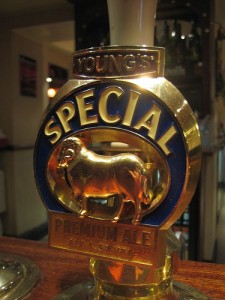Posted by British Brewer in
Recipes Full recipe and process can be found online here.
Full recipe and process can be found online here.
So begins our journey looking into some classic British Browns and Olds. First up, probably my favorite commercial Old Ale, Theakston Old Peculier from Masham in Yorkshire, England.
There is something really satisfying for the homebrewer when brewing an Old Ale recipe. Unlike the English Pale Ales we have just finished, which tend to more delicate and one mistake in any ingredient is heavily punished, it is really hard to mess up an Old Ale. What with the copious amounts of dark Jamaican sugar, Golden Syrup, Chocolate Malt and Molasses to compliment the mainstay Pale Malts and English Crystal. You end up with a rich, smooth almost rum like dark ale that will last forever in the cellar if we ever gave it a chance. So I must say I had a ton of fun with the Theakston recipe and have taken more than a few risks in the quest to faithfully recreate this quintessential Yorkshire Old Ale.
The family owned Theakston Brewery is located in the North of England in Masham, North Yorkshire. A town steeped in brewing history dating back to before William the Conqueror. The village of Theakston, and the namesake of the family was referenced in the Doomsday Book, created in 1089, and the Theakston coat of arms created in 1587 for Sir Richard Theakston whose descendent, Robert, in 1827 went on to create the first Theakston brewery in a pub called the Black Bull. In 1875 Roberts son Thomas takes over the brewery building a new one in the process, which is still used today. The company proceeded to grow buying many local breweries to meet growing demand. In 1984 the Theakston family joins the wave of independents selling to larger firms and finally decided to sell and the brewing of its flagship products moves away from historical Masham to larger capacity breweries of the acquirer. Now proceeds a story we have become familiar with, bigger company x sells to even bigger company y (in this case Matthew Brown PLC is bought by then North East England brewing giant Scottish and Newcastle, maker of Newcastle Brown, who in turn is taken over by Heineken in 2008). In 2004, as some previously Theakston owned breweries are closed and brewing operations moved as far north as Newcastle, four Theakston brothers buy back the company, making it an independent family owned brewery and in 2009 announced that brewing would again return to Masham after 35 years, bringing the story full circle.
On to the ale itself. According the The Real Ale Almanac this is the flavour profile we are trying to recreate:
Dark and vinous old ale bursting with complex fruit flavours. Massive winey bouquet of rich fruit with peppery hop notes. Toffee and roast malt in the mouth, deep bitter-sweet finish with delicate hops
On to the ingredients. The brewery website was actually very unforthcoming with ingredients. All they have posted is the use of Fuggles hops and a ABV of 5.6%. Its a start. The Real Ale Almanac was a little more helpful listing pale malt, crystal, unmalted cereal (torrified wheat) and sugars. Fuggles and “other” hops, with an IBU of 29, 48 24 SRM colour, and an OG of 1058.
This has to be the toughest challenge we have had yet. Typically by this point we have a complete list of hops and malts and enough variables in colour, gravity and bitterness to fire up the calculator and get to work. Instead we have incomplete hop information and no FG. What is most concerning is the vagueness around “sugars”. In English Pale classification ales sugar is used to bolster ABV with no flavour so its safe to assume cane sugar. With Old Ales all types of sryups and dark sugars are used, imparting dark rum like richness to the finished brew. This is going to be tough (but fun).
So time to consult the BJCP classification to see if we can gain any insights into the types of Crystal Malt and sugars used. Old Ales are listed under the classification of Strong Ales. Here we see Caramel Crystal Malts, and a sparing use of both Chocolate and Black Malts which is to be expected given the rich dark colour but not too much or risk imparting too much of the roasted smokey flavour. This ale is all richness and fruit. It is the following sentence in the BJCP guidelines that could help answer our question:
Adjuncts (such as molasses, treacle, invert sugar or dark sugar) are often used, as are starchy adjuncts (maize, flaked barley, wheat) and malt extracts
This helps greatly. So I then took to the internets and enquired into the sugar mix employed by other homebrewers attempting to recreate this historic ale. To my surprise I found consistency, the use of Golden Syrup, Molasses and Dark Sugar. The quantities varied but this should be enough to get us started.
The big question for me remains the yeast. We know we need fruit but at the same time we need a yeast that attenuates fairly well to get from a OG of 1058 to a final ABV of 5.6% (implied FG of approc 75%). It cannot be a dry finishing yeast because of the strong fruit flavours in the tasting notes. I scoured the yeast strains available to homebrewers and scratched my head. There are limited Yorkshire yeasts and I could find little to provide the level of fruit and attenuation implied by the data. Finally I got some inspiration from the Pretty Things Old Ale, inspired by Theakston Old Pecuilier among others, and their use of German and Belgian strains. So I started digging and hit pay dirt with various Belgian strains. You can have your cake and eat it to providing high attenuation and fruit flavour characteristics.
This just leaves the hops. Not so worried here, as the BJCP guidelines for Old Ale state:
Hop variety is not as important, as the relative balance and aging process negate much of the varietal character
So I am going to stick with Fuggles which will definitely provide the peppery hop notes, and we know the target IBU is 29. The calculator can do the rest.
Next stop is to input the ingredients into the beer calculus system on hopville.com and balance the quantities in order to create a workable recipe conforming as best we can to the constraints above.
Theakston Old Peculier (BJCP Beer Style: Strong Ale, category: Old Ale)
- 2.5 Gallon, 60 min boil
- OG 1060, FG 1011
- 6.3% ABV (slightly stronger but this is the mid-point range for the yeast with the 5.6% on the lower)
- 29 IBU
48 24° SRM (Dark Brown to Black)- Ready to drink in 2+ Months
Base Malt and Fermentables:
- 1 lb 8 oz Dark Dry Malt Extract (60 mins)
- 9 oz Light Dry Malt Extract (60 mins)
- 4 oz Lyles Golden Syrup (15 mins)
- 2 oz Black Molasses (15 mins)
- 8 oz Dark Candi Sugar (0 mins)
Specialty Grains:
- 2 oz Torrified Wheat
- 8 oz Caramel Crystal 60L
- 3 oz Chocolate Malt
- 3 oz Black Malt
Hops
- Bittering Hops – 0.67 oz Fuggles (60 mins)
- Flavour Hop – 0.53 oz Fuggles (15 mins)
Yeast
- White Labs Trappist Ale (WLP500)
Other Additions
- 1 tsp Irish Moss (15 mins)
Process
- Please follow the process guidelines outlined in my post here. You will require all the equipment specified here.
- Primary Fermentation: 7 days at 65-75°
- Secondary Fermentation: 2 weeks in the same location as the primary
- Prime and store in the bottle for at least 4 weeks before consuming
- Peak flavour will be reached after 4 weeks in the bottle
 I got a request via email today regarding a recipe for Youngs Ram Rod and Youngs Special. Its always great to receive email, it provides encouragement and support. It just so happens that I have a recipe for Youngs Special researched and ready to go but never got to post it given my desire to get going with the Old Ales.
I got a request via email today regarding a recipe for Youngs Ram Rod and Youngs Special. Its always great to receive email, it provides encouragement and support. It just so happens that I have a recipe for Youngs Special researched and ready to go but never got to post it given my desire to get going with the Old Ales.

